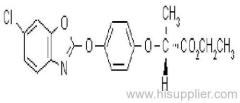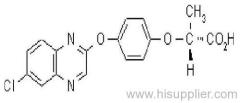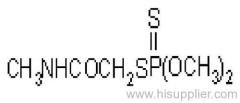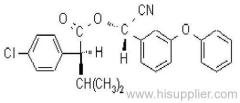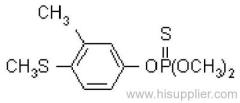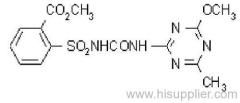
|
Shanghai Skyblue Chemical Co., Ltd.
|
Carbaryl
| Place of Origin: | Shanghai, China (Mainland) |
|
|
|
| Add to My Favorites | |
| HiSupplier Escrow |
Product Detail
Insecticide with contact and stomach action, and slight systemic properties.
Common name: carbaryl
IUPAC name: 1-naphthyl methylcarbamate
Chemical Abstracts name: 1-naphthalenyl methylcarbamate
CAS RN: [63-25-2]
PHYSICAL CHEMISTRY
Composition: Tech. grade is 99% pure. Mol. wt.: 201.2; M.f.: C12H11NO2; Form: Colourless to light tan crystals. M.p.: 142 ºC; V.p.: 4.1x10-2 mPa (23.5 ºC); KOW: logP = 1.85; Henry: 7.39x 10-5 Pa m3 mol-1 (calc.) S.g./density: 1.232 (20 ºC); Solubility: In water 120 mg/l (20 ºC). Readily soluble in polar organic solvents. In dimethylformamide, dimethyl sulfoxide 400-450, acetone 200-300, cyclohexanone 200-250, isopropanol 100, xylene 100 (all in g/kg, 25 ºC). Stability: Stable under neutral and weakly acidic conditions. Hydrolysed in alkaline media to 1-naphthol; DT50 c. 12 d (pH 7), 3.2 h (pH 9). Stable to light and heat. F.p.: 193 °C
APPLICATIONS
Biochemistry: Weak cholinesterase inhibitor.
Mode of action: Insecticide with contact and stomach action, and slight systemic properties. Uses: Control of Lepidoptera, Coleoptera, and other chewing and sucking insects, at 0.25-2.0 kg a.i./ha, on more than 120 different crops, including vegetables, tree fruit (including citrus), mangoes, bananas, strawberries, nuts, vines, olives, okra, cucurbits, peanuts, soya beans, cotton, rice, tobacco, cereals, beet, maize, sorghum, alfalfa, potatoes, ornamentals, forestry, etc. Control of earthworms in turf. Used as a growth regulator for fruit thinning of apples. Also used as an animal ectoparasiticide.
Phytotoxicity: Non-phytotoxic if used as directed. Under certain conditions, some varieties of apple and pear may be injured.
Formulation types: DP; GR; OF; RB; SC; TK; WP.
Compatibility: Incompatible with alkaline materials such as Bordeaux mixture, lime, and lime sulfur.
MAMMALIAN TOXICOLOGY
Oral: Acute oral LD50 for rats 264, female rats 500, rabbits 710 mg/kg.
Skin and eye: Acute percutaneous LD50 for rats >4000, rabbits >2000 mg/kg. Slight eye irritant, mild skin irritant (rabbits).
Inhalation: LC50 (4 h) for rats 3.28 mg/l air.
NOEL: (2 y) for rats 200 mg/kg diet.
ADI: 0.003 mg/kg b.w.
Toxicity class: WHO (a.i.) II; EPA (formulation) I ('Tercyl' 85WP), II ('Sevin' 80S), III
EC hazard R40| Xn; R22| N; R50
ECOTOXICOLOGY
Birds: Acute oral LD50 for young mallard ducks >2179, young pheasants >2000, Japanese quail 2230, pigeons 1000-3000 mg/kg.
Fish: LC50 (96 h) for rainbow trout 1.3, sheepshead minnow 2.2, bluegill sunfish 10 mg/l.
Daphnia: LC50 (48 h) 0.006 mg/l.
Algae: EC50 (5 d) for Selenastrum capricornutum 1.1 mg/l.
Other aquatic spp.: LC50 (96 h) for mysid shrimp (Mysidopsis bahia) 0.0057 mg/l; LC50 (48 h) for Eastern oyster (Crassostrea virginica) 2.7 mg/l.
Bees: Toxic to bees; LD50 (topical) 1 g/bee.
Worms: LC50 (28 d ) 106-176 mg/kg soil.
Other beneficial spp.: Toxic to beneficial insects.
ENVIRONMENTAL FATE
Animals: In mammals, carbaryl does not accumulate in body tissues, but is rapidly metabolised to non-toxic substances, particularly 1-naphthol. This, together with the glucuronic acid conjugate, is eliminated predominantly in the urine and faeces. Metabolism of carbamate insecticides is reviewed.
Plants: Metabolites are 4-hydroxycarbaryl, 5-hydroxycarbaryl and methylol-carbaryl.
Soil/Environment: Under aerobic conditions, carbaryl at 1 ppm degraded with DT50 7-14 d in a sandy loam and 14-28 d in a clay loam.




